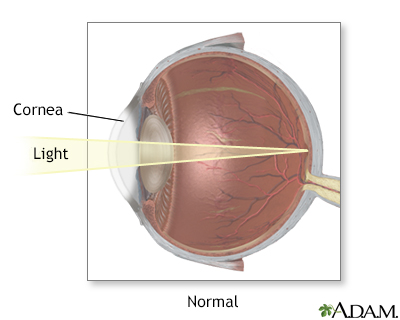
Hyperopia
Farsightedness is having a harder time seeing objects that are close than things that are far away.
The term is often used to describe the need for reading glasses as you get older. However, the correct term for that condition is presbyopia. Although related, presbyopia and hyperopia (farsightedness) are different conditions. People with hyperopia will also develop presbyopia with age.






Farsightedness is the result of the visual image being focused behind the retina rather than directly on it. It may be caused by the eyeball being too small or the focusing power being too weak. It can also be a combination of both.
Farsightedness is often present from birth. However, children have a very flexible eye lens, which helps make up for the problem. As aging occurs, glasses or contact lenses may be needed to correct the vision. If you have family members who are farsighted, you are also more likely to become farsighted.
Symptoms include:
Mild farsightedness may not cause any problems. However, you may need reading glasses sooner than people who do not have this condition.
A general eye exam to diagnose farsightedness may include the following tests:
This list is not all-inclusive.
Farsightedness is easily corrected with glasses or contact lenses. Surgery is available for correcting farsightedness in adults. This is an option for those who do not wish to wear glasses or contacts.
The outcome is expected to be good.
Farsightedness can be a risk factor for glaucoma and crossed eyes.
Contact your health care provider or eye doctor if you have symptoms of farsightedness and you have not had a recent eye exam.
Also, contact your provider if vision begins to get worse after you have been diagnosed with farsightedness.
See a provider right away if you think you have farsightedness and you suddenly develop the following symptoms:
Cioffi GA, Liebmann JM. Diseases of the visual system. In: Goldman L, Cooney KA, eds. Goldman-Cecil Medicine. 27th ed. Philadelphia, PA: Elsevier; 2024:chap 391.
Diniz D, Irochima F, Schor P. Optics of the human eye. In: Yanoff M, Duker JS, eds. Ophthalmology. 6th ed. Philadelphia, PA: Elsevier; 2023:chap 2.2.
Holmes JM, Kulp MT, Dean TW, et al. A randomized clinical trial of immediate versus delayed glasses for moderate hyperopia in children 3 to 5 years of age. Am J Ophthalmol. 2019;208:145-159. PMID: 31255587 pubmed.ncbi.nlm.nih.gov/31255587/.
BACK TO TOPReview Date: 7/23/2024
Reviewed By: Linda J. Vorvick, MD, Clinical Professor, Department of Family Medicine, UW Medicine, School of Medicine, University of Washington, Seattle, WA. Also reviewed by David C. Dugdale, MD, Medical Director, Brenda Conaway, Editorial Director, and the A.D.A.M. Editorial team.

|
A.D.A.M., Inc. is accredited by URAC, also known as the American Accreditation HealthCare Commission (www.urac.org). URAC's accreditation program is an independent audit to verify that A.D.A.M. follows rigorous standards of quality and accountability. A.D.A.M. is among the first to achieve this important distinction for online health information and services. Learn more about A.D.A.M.'s editorial policy, editorial process and privacy policy. A.D.A.M. is also a founding member of Hi-Ethics and subscribes to the principles of the Health on the Net Foundation (www.hon.ch). |
The information provided herein should not be used during any medical emergency or for the diagnosis or treatment of any medical condition. A licensed medical professional should be consulted for diagnosis and treatment of any and all medical conditions. Call 911 for all medical emergencies. Links to other sites are provided for information only -- they do not constitute endorsements of those other sites. © 1997- A.D.A.M., Inc. Any duplication or distribution of the information contained herein is strictly prohibited.